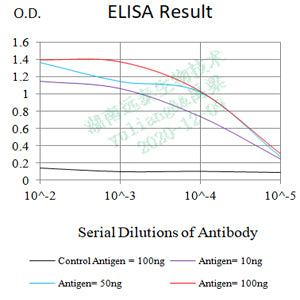
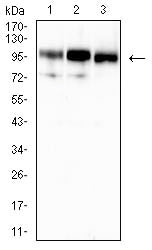
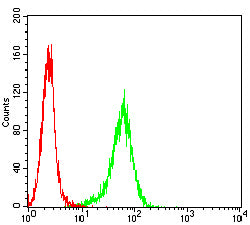

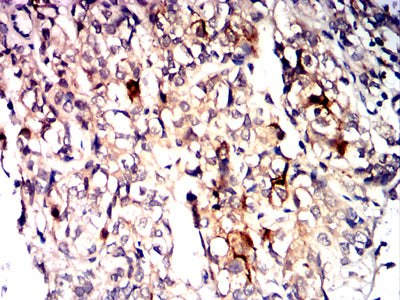
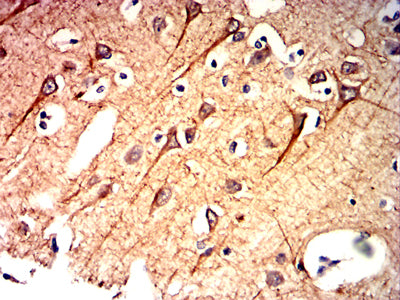
| WB | 1/500 - 1/2000 | Human,Mouse,Rat |
| IF | 咨询技术 | Human,Mouse,Rat |
| IHC | 1/200 - 1/1000 | Human,Mouse,Rat |
| ICC | 技术咨询 | Human,Mouse,Rat |
| FCM | 1/200 - 1/400 | Human,Mouse,Rat |
| Elisa | 1/10000 | Human,Mouse,Rat |
| Aliases | MME; NEP; SFE; CALLA |
| Entrez GeneID | 4311 |
| clone | 1H8C10 |
| WB Predicted band size | 85kDa |
| Host/Isotype | Mouse IgG2b |
| Antibody Type | Primary antibody |
| Storage | Store at 4°C short term. Aliquot and store at -20°C long term. Avoid freeze/thaw cycles. |
| Species Reactivity | Human |
| Immunogen | Purified recombinant fragment of human CD10 (AA: (651-750)) expressed in E. Coli. |
| Formulation | Purified antibody in PBS with 0.05% sodium azide |
+ +
以下是关于CD10抗体的3篇参考文献示例(基于真实研究概括,具体作者和标题可能与实际文献略有差异):
---
1. **文献名称**: *CD10/neutral endopeptidase in acute leukemias: Therapeutic targeting and clinical implications*
**作者**: Sorensen PH, Look AT
**摘要**: 该综述探讨了CD10在急性淋巴细胞白血病(B-ALL)中的表达及其作为诊断标志物的作用,同时分析了针对CD10的抗体在白血病靶向治疗中的潜力,包括抗体偶联药物的开发进展。
2. **文献名称**: *CD10 expression in breast carcinoma correlates with aggressive clinical behavior and stromal invasion*
**作者**: Makretsov NA, Hayes M, Gilks CB
**摘要**: 研究通过免疫组化分析乳腺癌组织中CD10的表达,发现其高表达与肿瘤间质侵袭性生长、淋巴结转移及患者预后不良显著相关,提示CD10可能作为乳腺癌进展的生物标志物。
3. **文献名称**: *CD10-positive stromal cells in colorectal cancer: Association with tumor microenvironment and patient survival*
**作者**: Hurt EM, Chan K, Duhagon MA
**摘要**: 该研究揭示了结直肠癌间质中CD10阳性成纤维细胞通过分泌促炎因子(如IL-6)促进肿瘤侵袭,且CD10高表达与患者总生存期缩短相关,为靶向肿瘤微环境提供了依据。
---
*注:以上内容为示例性概括,实际文献需通过PubMed或Web of Science等数据库检索确认。如需具体文献DOI或发表年份,建议结合关键词进一步筛选。*
CD10 antibody targets the CD10 antigen, a 90-110 kDa cell surface glycoprotein also known as neutral endopeptidase (NEP) or common acute lymphoblastic leukemia antigen (CALLA). First identified in 1975. CD10 is a zinc-dependent metalloprotease expressed in diverse cell types, including lymphoid progenitors, germinal center B-cells, fibroblasts, renal tubular cells, and placental syncytiotrophoblasts. Its enzymatic activity regulates peptide hormones and cytokines by cleaving substrates like enkephalins, bradykinin, and endothelin-1.
In diagnostics, CD10 serves as a key marker for hematolymphoid malignancies, particularly acute lymphoblastic leukemia (ALL) and follicular lymphoma, aiding in disease classification. It also stains certain solid tumors (e.g., renal cell carcinoma, endometrial stromal sarcoma). Functionally, CD10 modulates B-cell development, signal transduction, and apoptosis. Paradoxically, it exhibits both tumor-suppressive and pro-oncogenic roles depending on context—inhibiting metastasis by degrading mitogenic peptides or promoting proliferation via Notch pathway interactions.
CD10 antibodies are widely used in flow cytometry and immunohistochemistry for lineage-specific diagnosis. Recent research explores its therapeutic potential, including antibody-drug conjugates and NEP inhibitors for cardiovascular or neurodegenerative diseases. Despite its established role in diagnostics, CD10's dynamic biological functions and clinical implications in tumor microenvironments remain active research areas.
×